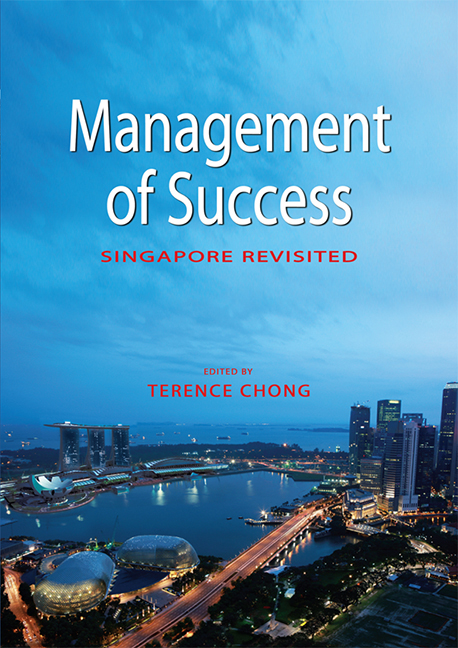Book contents
- Frontmatter
- Contents
- List of Tables and Figures
- Foreword
- Message
- Quote
- Preface
- The Contributors
- 1 Introduction: The Role of Success in Singapore's National Identity
- SECTION 1 SINGAPORE IN THE BIGGER PICTURE
- SECTION 2 LEADERSHIP, POLICY AND POLITICS
- SECTION 3 THE RESTRUCTURING OF THE ECONOMY
- SECTION 4 THE TRANSFORMATION OF SOCIETY
- SECTION 5 THE LAW
- SECTION 6 MODIFICATION OF THE ENVIRONMENT
- 21 The Greening of the Global City
- 22 Recovering from the “Promethean Hangover”? Critical Reflections on the Remaking of Singapore as a Global City
- 23 The Four Taps: Water Self-sufficiency in Singapore
- SECTION 7 COMMUNITY AND NATIONAL SECURITY
- SECTION 8 LIFE IN SINGAPORE
- Index
23 - The Four Taps: Water Self-sufficiency in Singapore
from SECTION 6 - MODIFICATION OF THE ENVIRONMENT
Published online by Cambridge University Press: 21 October 2015
- Frontmatter
- Contents
- List of Tables and Figures
- Foreword
- Message
- Quote
- Preface
- The Contributors
- 1 Introduction: The Role of Success in Singapore's National Identity
- SECTION 1 SINGAPORE IN THE BIGGER PICTURE
- SECTION 2 LEADERSHIP, POLICY AND POLITICS
- SECTION 3 THE RESTRUCTURING OF THE ECONOMY
- SECTION 4 THE TRANSFORMATION OF SOCIETY
- SECTION 5 THE LAW
- SECTION 6 MODIFICATION OF THE ENVIRONMENT
- 21 The Greening of the Global City
- 22 Recovering from the “Promethean Hangover”? Critical Reflections on the Remaking of Singapore as a Global City
- 23 The Four Taps: Water Self-sufficiency in Singapore
- SECTION 7 COMMUNITY AND NATIONAL SECURITY
- SECTION 8 LIFE IN SINGAPORE
- Index
Summary
This (water) dominated every other policy. Every other policy had to bend at the knees for water survival.
— Lee Kuan Yew, 2008THE JOURNEY TOWARDS WATER SELF-SUFFICIENCY
The story of Singapore's journey towards water self-sufficiency is not only a story of the country's will and ability, but also one of insecurity and paradigm shifts. According to Minister Mentor Lee Kuan Yew, two incidents underlined Singapore's water insecurities. The first was in 1942 when the Japanese troops advancing from Malaysia blew up pipes transporting water to Singapore. The second was on the day of Singapore's independence in 1965, when the then Malaysian Prime Minister Tungku Abdul Rahman threatened that Malaysia would threaten to cut off supplies of water to Singapore if its foreign policy was prejudicial to that of Malaysia's. Since then, the challenge for policy-makers has always been to ensure the sustainability of clean water supplies in order to support the country's future economic development and population needs.
However, in recent years there has been a paradigm shift over the use of the country's reservoirs. Not too long ago reservoirs in Singapore were offlimits to the general public. As precious sources of water, the city-state's reservoirs were restricted areas jealously guarded by the Singapore state. They were sealed from the public, to be seen but not to be touched. Today, reservoirs are regarded by policy-makers as a site the public can engage with through a variety of water activities and sports. The Bedok and MacRitchie Reservoirs for instance, are now home to wakeboarding, sailing and kayaking enthusiasts. From a site of restriction to one where Singaporeans are encouraged to form a sense of ownership, Singapore's reservoirs demonstrate the mindset change undertaken by policy-makers with regards to water. This chapter examines Singapore's policies for managing its scarce water resources. What have been some of the challenges facing policy-makers? At what expense has additional water supplies been created? Was the decision to increase locally sourced water supplies economically and politically expedient?
Singapore is an island and urban city-state with no rural hinterland. The main island and a number of islets scattered off its north-east and southern parts occupy a land area of around 699 km2. Singapore is not short of fresh water as it receives an average of about 2,400 mm of rainfall annually, well above the global average of 1,050 mm.
- Type
- Chapter
- Information
- Management of SuccessSingapore Revisited, pp. 417 - 440Publisher: ISEAS–Yusof Ishak InstitutePrint publication year: 2010

